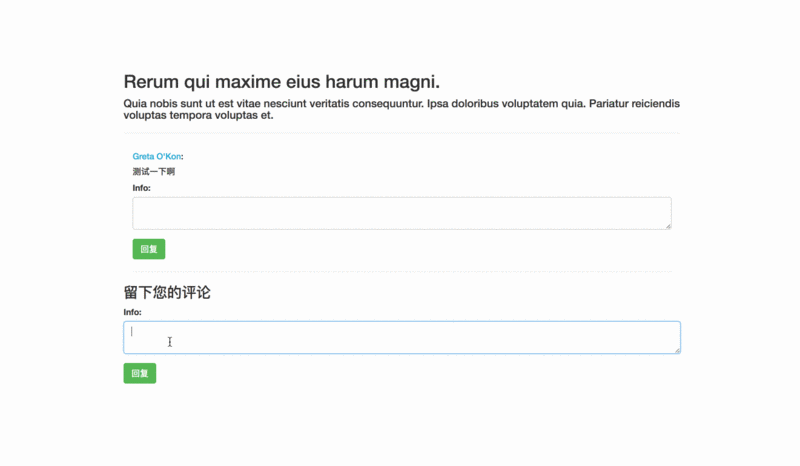
本篇文章给大家带来的内容是关于Laravel5实现嵌套评论的形式(代码详解),有一定的参考价值,有需要的朋友可以参考一下,希望对你有所帮助。
经常我们看见评论显示形式有很多,比如'@'某某,又或者像知乎的收缩式的评论,又或者是嵌套式的评论,那么最一开始也是最常见的就是嵌套式评论,因为这个更加醒目.
准备工作
1、设计三张表users,posts,comments,表结构如下:
users
Schema::create('users', function (Blueprint $table) {
$table->increments('id');
$table->string('name');
$table->string('email')->unique();
$table->string('password');
$table->rememberToken();
$table->timestamps();
});posts
Schema::create('posts', function (Blueprint $table) {
$table->increments('id');
$table->string('title');
$table->integer('user_id')->index();
$table->text('content');
$table->timestamps();
});comments
Schema::create('comments', function (Blueprint $table) {
$table->increments('id');
$table->integer('user_id')->index();
$table->integer('post_id')->index();
$table->integer('parent_id')->index()->default(0);
$table->text('body');
$table->timestamps();
});2.Model层:
Post.php文件
/**
* 一篇文章有多个评论
* @return \Illuminate\Database\Eloquent\Relations\HasMany
*/
public function comments()
{
return $this->hasMany(Comment::class);
}
/**
* 获取这篇文章的评论以parent_id来分组
* @return static
*/
public function getComments()
{
return $this->comments()->with('owner')->get()->groupBy('parent_id');
}Comments.php文件
/**
* 这个评论的所属用户
* @return \Illuminate\Database\Eloquent\Relations\BelongsTo
*/
public function owner()
{
return $this->belongsTo(User::class, 'user_id');
}
/**
* 这个评论的子评论
* @return \Illuminate\Database\Eloquent\Relations\HasMany
*/
public function replies()
{
return $this->hasMany(Comment::class, 'parent_id');
}逻辑编写
我们所要实现的嵌套评论其实在我们准备工作中已经 有点思路了,我们首先将一篇文章显示出来,同时利用文章与评论的一对多关系,进行显示所有的评论,但是我们的评论里面涉及到一个字段就是parent_id,这个字段其实非常的特殊,我们利用这个字段来进行分组, 代码就是上面的return $this->comments()->with('owner')->get()->groupBy('parent_id'),具体的过程如下:
web.php文件
\Auth::loginUsingId(1); //用户id为1的登录
//显示文章和相应的评论
Route::get('/post/show/{post}', function (\App\Post $post) {
$post->load('comments.owner');
$comments = $post->getComments();
$comments['root'] = $comments[''];
unset($comments['']);
return view('posts.show', compact('post', 'comments'));
});
//用户进行评论
Route::post('post/{post}/comments', function (\App\Post $post) {
$post->comments()->create([
'body' => request('body'),
'user_id' => \Auth::id(),
'parent_id' => request('parent_id', null),
]);
return back();
});视图代码
视图方面我们需要实现嵌套,那么随着用户互相评论的越来越多的话,那么嵌套的层级也就越多,所以说,我们这里需要使用各小技巧来显示整个评论,我们使用@include()函数来显示,那么我们试图的结构如下:
- comments comments.blade.php form.blade.php list.blade.php - posts show.blade.php
代码如下:
show.blade.php
<!DOCTYPE html>
<html>
<head>
<meta charset="utf-8">
<meta http-equiv="X-UA-Compatible" content="IE=edge">
<meta name="viewport" content="width=device-width, initial-scale=1">
<link href="//cdn.bootcss.com/bootstrap/3.3.6/css/bootstrap.min.css" rel="stylesheet">
</head>
<body>
<div style="margin-top: 100px">
<div class="col-md-10 col-md-offset-1">
<h2>{{$post->title}}</h2>
<h4>{{$post->content}}</h4>
<hr>
@include('comments.list',['collections'=>$comments['root']])
<h3>留下您的评论</h3>
@include('comments.form',['parentId'=>$post->id])
</div>
</div>
</body>
</html>comment.blade.php
<div class="col-md-12">
<h5><span style="color:#31b0d5">{{$comment->owner->name}}</span>:</h5>
<h5>{{$comment->body}}</h5>
@include('comments.form',['parentId'=>$comment->id])
@if(isset($comments[$comment->id]))
@include('comments.list',['collections'=>$comments[$comment->id]])
@endif
<hr>
</div>form.blade.php
<form method="POST" action="{{url('post/'.$post->id.'/comments')}}" accept-charset="UTF-8">
{{csrf_field()}}
@if(isset($parentId))
<input type="hidden" name="parent_id" value="{{$parentId}}">
@endif
<div class="form-group">
<label for="body" class="control-label">Info:</label>
<textarea id="body" name="body" class="form-control" required="required"></textarea>
</div>
<button type="submit" class="btn btn-success">回复</button>
</form>list.blade.php
@foreach($collections as $comment)
@include('comments.comment',['comment'=>$comment])
@endforeach最终效果图如下

Atas ialah kandungan terperinci Laravel5实现嵌套评论的形式(代码详解). Untuk maklumat lanjut, sila ikut artikel berkaitan lain di laman web China PHP!
 Bagaimana untuk membuka fail php
Bagaimana untuk membuka fail php
 Bagaimana untuk mengalih keluar beberapa elemen pertama tatasusunan dalam php
Bagaimana untuk mengalih keluar beberapa elemen pertama tatasusunan dalam php
 Apa yang perlu dilakukan jika penyahserialisasian php gagal
Apa yang perlu dilakukan jika penyahserialisasian php gagal
 Bagaimana untuk menyambungkan php ke pangkalan data mssql
Bagaimana untuk menyambungkan php ke pangkalan data mssql
 Bagaimana untuk menyambung php ke pangkalan data mssql
Bagaimana untuk menyambung php ke pangkalan data mssql
 Bagaimana untuk memuat naik html
Bagaimana untuk memuat naik html
 Bagaimana untuk menyelesaikan aksara bercelaru dalam PHP
Bagaimana untuk menyelesaikan aksara bercelaru dalam PHP
 Bagaimana untuk membuka fail php pada telefon bimbit
Bagaimana untuk membuka fail php pada telefon bimbit